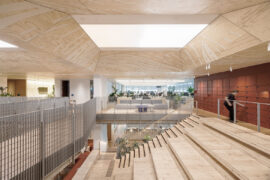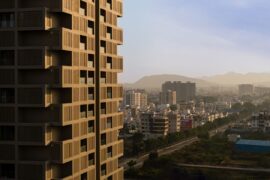American hardwood may just be the answer to our timber shortage woes, and our stringent sustainability requirements. The American Hardwood Export Council provides indispensable insight into the topic.

Forest Tales | Photography Petr Krejci
September 5th, 2022
An imperative to modern-day design and architecture, sustainability calls on all to properly appreciate the affordances of the materials we use in construction and fit-out. With European hardwoods stocks affected, supply lines disrupted, and demand outweighing growth, the potential is there for American hardwood. It can not only fulfil demand, but deliver on sustainability.
In the wake of the pandemic, the American Hardwood Export Council (AHEC) has observed architects, builders and designers broadening their horizons in sustainable timber, with American hardwoods such as maple, cherry and red oak standing out for more than just their beauty.

In the wake of the pandemic, the American Hardwood Export Council (AHEC) has observed architects, builders and designers broadening their horizons in sustainable timber, with American hardwoods such as maple, cherry and red oak standing out for more than just their beauty.


Left: Migo 01 by Pascal Hien | Photography Jason Yates
Right: Humble Administrator’s Table and Chairs by Studio Swine
Versatile, robust, and rapidly renewable (with a growth rate that is notably faster than the harvest rate), these three American hardwoods are abundant in the forest and as yet under-utilised.

Through events such as Forest Tales, staged by AHEC at the Milan Design Week in June, it is looking to address misconceptions about timber generally and share the specific advantages of using American hardwoods.


Left: Kadamba Gate by Ini Archibong | Photography David Cleveland
Right: Stem by Thomas Heatherwick | Photography David Cleveland
Director of AHEC Europe, David Venables says Forest Tales brought together a “celebration of exceptional design from AHEC’s latest projects, a love for timber and a much-needed call for balance”. That is, “balance in the way we use natural materials with particular emphasis on renewable ones, such as wood.”

Forest Tales aimed to show off the beauty American hardwood, offering invaluable insights into planting, crafting and more. There were also never-before-seen designs that revealed the timber’s extraordinary potential.


Left: Ikare by Taiho Shin | Photography Tim Robinson
Right: Forest Tales | Photography Petr Krejci
“Forest Tales reflects on how the use of a wider range of sustainable materials, such as the three US hardwoods featured in the exhibition, and all wood species in general, proportionate to what grows in the forest, makes the use of the resource and the way we consume more thoughtful and responsible,” says Venables.
Many of Australia’s top designers have been using American hardwoods for years, with the likes of Adam Goodrum, John Goulder, Adam Markowitz and Tom Fereday turning to it as their preferred material.

American hardwoods arrive on Australian shores carbon negative. This is timber not from plantations but from forest that well managed and selectively harvested for generations by private landowners. Significant investment in an ISO conformant life cycle assessment tool by AHEC offers certainty to specifiers and designers that their material choice is a sound from an environmental perspective.


Left: Thought Bubble by Nong Chotipatoomwan | Photography Winston Change
Right: Roof Stool by Trang Nguyen | Photography Winston Change
“For the first time, the entire industry ecosystem, including designers, specifiers and consumers, seems aligned in wanting to do the right thing in the face of the environmental imperative,” comments Venables.

We think you might like this story about the Autex Acoustics®Acoustic Timber, which bridges the gap for a Group 1 fire-rated, carbon neutral acoustic solution.
INDESIGN is on instagram
Follow @indesignlive
A searchable and comprehensive guide for specifying leading products and their suppliers
Keep up to date with the latest and greatest from our industry BFF's!
The new range features slabs with warm, earthy palettes that lend a sense of organic luxury to every space.

It’s widely accepted that nature – the original, most accomplished design blueprint – cannot be improved upon. But the exclusive Crypton Leather range proves that it can undoubtedly be enhanced, augmented and extended, signalling a new era of limitless organic materiality.

Gaggenau’s understated appliance fuses a carefully calibrated aesthetic of deliberate subtraction with an intuitive dynamism of culinary fluidity, unveiling a delightfully unrestricted spectrum of high-performing creativity.

How can design empower the individual in a workplace transforming from a place to an activity? Here, Design Director Joel Sampson reveals how prioritising human needs – including agency, privacy, pause and connection – and leveraging responsive spatial solutions like the Herman Miller Bay Work Pod is key to crafting engaging and radically inclusive hybrid environments.

Reuse, resourcefulness and material transformations bring unexpected stories to Arup’s new Brisbane office, designed by Hassell.

The second installment in our three-part series on collaborations between the world’s best designers and the American Hardwood Export Council
The internet never sleeps! Here's the stuff you might have missed

In this episode of Stories Indesign, architects from Studio Johnston, Sam Crawford Architects, SAHA and Carter Williamson discuss their involvement in the recently launched NSW Pattern Book.

Screen 504 is a multi-residential building that pays homage to the past by reinterpreting traditional design for the future.